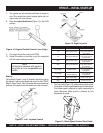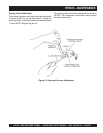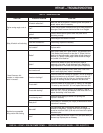
HTH44T • RIDE-ON POWER TROWEL — OPERATION & PARTS MANUAL — REV. #8 (03/27/12) — PAGE 23
— PAGE RM
Figure 19. Pressure Gauge (Hydraulic Pump)
Once the pressure gauges are installed and the spiders chained
together, the system can be checked.
With the foot pedal in the idle position and the engine at full
speed, the pressure should be 200 to 300 psi. If the pressure
is less than 200 psi, the charge system may need to be
inspected and/ or serviced. In particular, the suction filter and
charge pump relief valve should be checked. The suction filter
may be plugged, or the relief valve may be stuck. Either
condition may cause low charge pressure.
With the engine at 50% to 70% of full speed, and spiders
chained together, slowly depress the foot pedal and read the
gauges. The pressure should get to at least 3,100 psi. If the
pressure will not attain 3,100 psi, the pump should be inspected
and/or serviced by an authorized service representative.
Checking Hydraulic Pressure
It should be mentioned that most hydraulic problems are a
result of low fluid levels. Before checking any other possibilities,
make sure the hydraulic fluid level is half way up the sight
glass which is located at the right end of the frame.
Hydraulic pressure can be checked using a pressure gauge
(Figure 19) with a range of at least 5,000 psi. Two male
diagnostic quick couplers (one for each pump) are located in
the elbow fittings (Figure 19) at the front of the pump. It is best
to use two gauges simultaneously, but it is possible to use
only one gauge and repeat the procedure for each side.
To fully test the hydraulic system, the spiders will need to be
locked so that they cannot rotate. This can easily be done by
wrapping a chain around an arm on each spider, thus chaining
them together in the back of the trowel.
HTH44T— MAINTENANCE


















